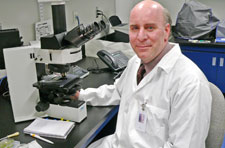Molecular scientist returns to Montreal

Robin N. Michel has joined the faculty as a Tier 1 Canada Research Chair. He brings an international reputation and multidisciplinary interests.
Photo by Marc Losier
Montreal-born physiologist Robin N. Michel joined the Department of Exercise Science in July. Since 1987, he had been at Laurentian University in Sudbury, where he established an international reputation for his work on calcineurin, an enzyme that acts as a sensor for calcium levels in cells.
At Concordia, as a Tier 1 Canada Research Chair in Cellular and Molecular Neuromuscular Physiology, he will continue that research in the new Richard J. Renaud Science Complex’s state-of-the art laboratories.
Michel was the first scientist to demonstrate the key role of calcineurin in the sequence of events that prompt muscle cells to grow and become more energy-efficient.
“We’ve long known that nerves and muscles work together, that their interactions are not just one way, that there is communication going on,” he explained.
“This communication, in part, is electrical in nature — the nerves send impulses and the muscle fibres contract — but these electrical signals have to be deciphered in some fashion.”
The key was to find a way to decode those signals from an electrical to a molecular message. Calcineurin seemed to be an ideal candidate for that decoding.
Michel has always subscribed to multidisciplinary journals to keep abreast of discoveries in other fields. Calcineurin first came to his attention when he read about its role as a calcium decoder in immune cells.
"Nerves and muscles work together [but] their interactions are not just one-way”
He noted a similarity between the way calcium levels oscillate in immune cells and the way calcium oscillates in excitable cells such as muscles. His research soon identified calcineurin and similar mechanisms of calcium deciphering in muscle cells.
He compares the signals responsible for muscle growth to a perfect symphony, with calcineurin acting like the first violin in an orchestra: it takes the lead but plays in concert with all the other instruments.
Michel is also trying to understand the roles of other, similar molecules in the hope that this research into nerve and muscle signaling may lead to new therapeutic strategies to counter muscle wasting and weakness.
Greater understanding of the role of calcineurin has implications for nerve and muscle diseases such as muscular dystrophy, amyo-trophic lateral sclerosis and multiple sclerosis, and this research may eventually point to treatment avenues.
It may also help identify the amount of exercise needed to prevent muscle atrophy from lack of use, either because of nerve damage, or in the case of astronauts, muscles that do not bear weight in space.
“We are trying to understand all the steps from electrical activity to decoding of the molecules involved so we can better intervene,” he said.
Michel’s third line of research involves studying so-called trophic chemicals that are released by nerve cells, and that mediate the growth of muscle fibres.
“Calcineurin is an important molecule, but it doesn’t act alone; there are other pathways and other signaling molecules that need to be identified.” He expects a paper he wrote identifying one such molecule for the first time will soon be published.
With his multidisciplinary bent, the move to Concordia suits him well. He already has cross-appointments to Chem-istry and Biochemistry, and may soon also have a cross-appointment to Biology. “This allows me access to students and potential collaborators.”
The CRC appointment brings $1.4 million over seven years and more than $600,000 in Canada Foundation for Innovation funds for laboratory equipment.